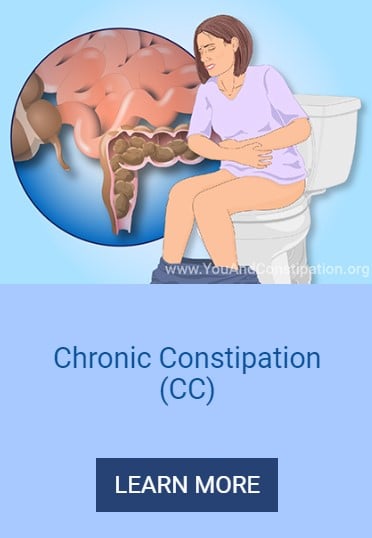Start with your healthcare provider for a diagnosis
It may be uncomfortable to talk to a healthcare provider about your constipation, but keep in mind that it is a very common condition, and your provider is there to help. To assist with this discussion, keep a diary of symptoms, preferably when you are not taking laxatives. The following are important things to record:
- when your symptoms began
- how frequently they occur
- any associated pain
- how often you have bowel movements (BMs)
- the texture of your BMs (hard, lumpy, sausage-like, soft and mushy, watery)
- if you are straining on the toilet
- if you are having difficulty passing a BM
- if you feel as though something’s blocking your BM from coming out
- if you must remove BMs manually
- any factors which you feel worsen or improve your symptoms.
Your healthcare provider may also ask if you have developed any alarm signs or alarm symptoms. This will help rule out diseases or conditions other than chronic constipation. It is important for you to also discuss how the symptoms are affecting your life.
A physical examination should be performed. This will focus on your abdomen and the area in and around the anus. These exams may detect secondary complications caused by constipation including, but not limited to:
- Hemorrhoid(s) – The veins around the anus or lower rectum that are swollen and inflamed
- Anal fissure – A crack, cut, or tear in the skin in or adjacent to the anus or anal canal
- Rectal prolapse – A condition where rectal tissue comes out of the anus when attempting to have a bowel movement
Your healthcare provider may also perform a digital rectal examination (DRE) in an initial attempt to identify a functional defecation disorder (FDD). Your provider will insert a gloved, lubricated finger in your anus to check for any abnormal findings. They may ask you to push, squeeze, or attempt to expel the finger. These maneuvers evaluate your ability to coordinate the muscles of the pelvic floor used to pass BMs. In women, a rectocele (a bulge of the rectum into the vaginal wall) may be detected. Abnormal masses or strictures can also be identified during this exam.
“Alarm Signs” or “Alarm Symptoms”
Healthcare providers use the checklist of symptoms below to make sure something other than constipation is not causing your constipation. They are often called “Alarm signs” or “Alarm Symptoms,” and they include:
- Blood in bowel movements – This blood can be bright red to black in color and may be in or around
bowel movements. - Low blood counts (anemia) – This is determined by blood work or lab tests ordered by a healthcare
provider. - New onset of symptoms over the age of 50
- Losing weight without trying
- Diarrhea that wakes you up from sleep at night
- A family history of IBD, colon cancer, or celiac disease.
These alarm signs are usually not explained by constipation and can indicate other medical problems. If these symptoms occur, bring them to the attention of a healthcare provider to perform additional tests.
Diagnostic Testing
In most instances, no diagnostic testing is required. However, if the constipation doesn’t respond to standard treatments, has begun suddenly, or is associated with alarm signs or symptoms, further testing may be needed. These studies may include simple blood tests to more advanced/specialized tests.
- Abdominal X-ray: This is a simple x-ray of your abdomen and can be useful for evaluating the amount of BM in your colon. Your healthcare provider may order this test if the constipation begins suddenly, is worried that an obstruction (blockage) is causing the constipation, or if your symptoms seem consistent with overflow diarrhea.
- Colonoscopy: A colonoscopy is a simple test that does not involve cutting into the body. A physician using a long flexible tube called an endoscope. This tube has a camera and light on the end. This tool allows your physician to see inside your GI tract to examine the lower portion of the GI tract. This flexible tube is inserted through the anus, into the rectum and large intestine
- Anorectal Manometry (ARM): This test is used to identify evacuation disorders in individuals whose constipation is not helped by laxatives. ARM specifically evaluates the coordination of the pelvic floor muscles. A small probe containing sensors with a balloon at its tip is inserted approximately 10 centimeters (cm) into the rectum. You will be asked to perform a set of simple and usually painless maneuvers which include squeezing the anal muscles, coughing, and attempting to push the probe out of your bottom. The sensors will provide estimates of the strength of the pelvic floor muscles and whether these muscles relax (to allow for easy passage of BMs) or spasm (blocking BMs from exiting the body). The balloon at the end of the catheter is used to check the nerves in the rectum. The balloon is slowly inflated, and you will be asked to let the healthcare provider know when you first can feel the balloon, when it causes an urge to have a BM, and when the urge is so strong that it can no longer be ignored.
- Balloon Expulsion Test (BET): This study, usually performed with the ARM, has the highest accuracy for diagnosing a functional defecation disorder (FDD) because it simulates an attempt to pass a BM from the rectum. The balloon at the tip of the probe is filled with 50 milliliters of water. Then, while lying on your left side or while sitting on a toilet, you will be asked to try to pass it like you would a normal BM.
- Radiopaque Marker Study (ROM): Unlike the ARM and BET, which are used to diagnose FDDs, the ROM test is more useful for identifying evidence of slow transit constipation (STC), or delayed movement of BMs through the colon. There are multiple variations of this study. However, the patient will be asked to swallow capsules which contain small markers that can be detected via xray. The healthcare provider will use a special camera to take pictures to see how far the substance has moved through the body at specific times. This test is usually performed after the ARM and/or BET because approximately 50% of individuals with a FDD will develop STC. Therefore, testing for a FDD should be performed first.
- Defecography: This is a test that is used to evaluate for anatomical causes of evacuation disorders, and/or identify lack of coordination of the pelvic floor muscles not detected by ARM. For this study, a barium solution is inserted into the rectum. You may be asked to either sit on a commode in the natural seated position or lie on an exam table on your back or left side. While in this position, you will be asked to perform a set of simple and usually painless maneuvers which include squeezing the anal muscles, coughing, and attempting to push the barium solution out of your bottom. The study will use either X-Ray or MRI imaging to capture how the body performs these tasks. In some instances, anatomical changes may be found during this study which are secondary and not the cause of the constipation. It is important to carefully review the findings of this study with your healthcare provider.
- Colon Manometry: A large catheter is placed in the colon and is used to measure the strength of the muscles in the colon. It is used to try to determine the cause of delays in the time it takes for things to move through your colon.
Learn more about specialized tests for constipation
Chronic Constipation (CC) is a complex, symptoms based disorder that may occur as a result of multiple factors. Most cases of CC can be treated prior to extensive diagnostic testing unless there are alarm symptoms present. If the first few attempts at treatment do not work, testing may be used to identify specific causes. This will help find a treatment program that best fits the patient. Working closely with a healthcare provider and discussing the symptoms thoroughly will help you find the best treatment plan for you. Treatment decisions may be based on a combination of factors including ease of use, treatment effectiveness, safety, cost, insurance coverage, and therapy goals.
Constipation and Irritable Bowel Syndrome
Irritable bowel syndrome (IBS) is a functional disorder characterized by symptoms of abdominal discomfort or pain, usually in the lower abdomen (although the location and intensity are variable, even at different times within the same person), and altered bowel habit (change in frequency or consistency) – chronic or recurrent constipation, diarrhea, or both in alternation.
People with irritable bowel syndrome may have symptoms that overlap with functional constipation. However, patients with functional constipation may not have the abdominal discomfort or pain that is required to make a diagnosis of IBS, and would not have intervals of normal bowel habit and diarrhea with loose stools that can occur in IBS.
You and Constipation
Visit our You and Constipation to learn more about Chronic Constipation and Pelvic Floor Disorders

Adapted from IFFGD Publication: Constipation Overview by Darren Brenner , M.D., AGAF, FACG, Associate Professor andDirector of the Neurogastromotility Program, Division of Gastroenterology, Northwestern University Feinberg School of Medicine, Chicago, IL








